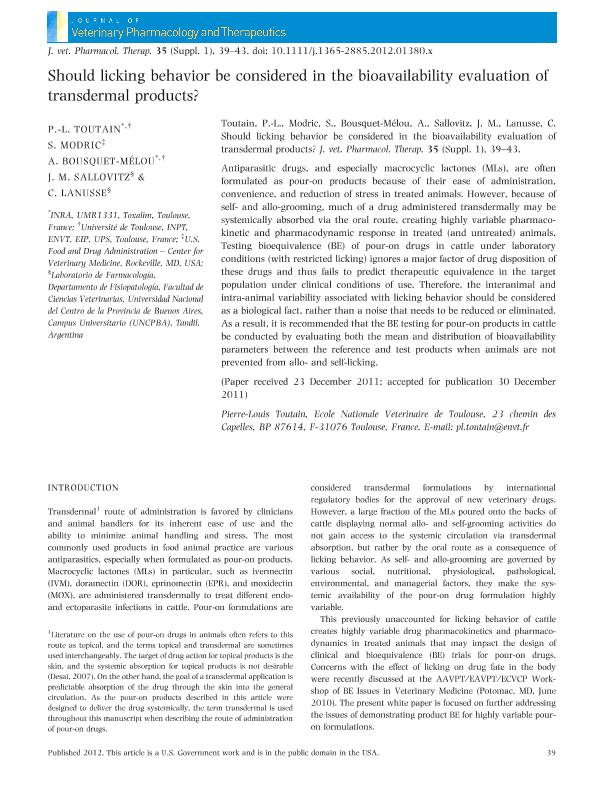Mostrar el registro sencillo del ítem
dc.contributor.author
Toutain, P. L.
dc.contributor.author
Modric, S.
dc.contributor.author
Bousquet Mélou, A.
dc.contributor.author
Sallovitz, Juan Manuel

dc.contributor.author
Lanusse, Carlos Edmundo

dc.date.available
2019-02-25T17:42:15Z
dc.date.issued
2012-04
dc.identifier.citation
Toutain, P. L.; Modric, S.; Bousquet Mélou, A.; Sallovitz, Juan Manuel; Lanusse, Carlos Edmundo; Should licking behavior be considered in the bioavailability evaluation of transdermal products?; Wiley Blackwell Publishing, Inc; Journal of Veterinary Pharmacology and Therapeutics; 35; SUPPL. 1; 4-2012; 39-43
dc.identifier.issn
0140-7783
dc.identifier.uri
http://hdl.handle.net/11336/70783
dc.description.abstract
Antiparasitic drugs, and especially macrocyclic lactones (MLs), are often formulated as pour-on products because of their ease of administration, convenience, and reduction of stress in treated animals. However, because of self- and allo-grooming, much of a drug administered transdermally may be systemically absorbed via the oral route, creating highly variable pharmacokinetic and pharmacodynamic response in treated (and untreated) animals. Testing bioequivalence (BE) of pour-on drugs in cattle under laboratory conditions (with restricted licking) ignores a major factor of drug disposition of these drugs and thus fails to predict therapeutic equivalence in the target population under clinical conditions of use. Therefore, the interanimal and intra-animal variability associated with licking behavior should be considered as a biological fact, rather than a noise that needs to be reduced or eliminated. As a result, it is recommended that the BE testing for pour-on products in cattle be conducted by evaluating both the mean and distribution of bioavailability parameters between the reference and test products when animals are not prevented from allo- and self-licking.
dc.format
application/pdf
dc.language.iso
eng
dc.publisher
Wiley Blackwell Publishing, Inc

dc.rights
info:eu-repo/semantics/openAccess
dc.rights.uri
https://creativecommons.org/licenses/by-nc-sa/2.5/ar/
dc.subject
Licking Behaviour
dc.subject
Moxidectin
dc.subject
Bovine
dc.subject
Percutaneous Absorption
dc.subject.classification
Ciencias Veterinarias

dc.subject.classification
Ciencias Veterinarias

dc.subject.classification
CIENCIAS AGRÍCOLAS

dc.title
Should licking behavior be considered in the bioavailability evaluation of transdermal products?
dc.type
info:eu-repo/semantics/article
dc.type
info:ar-repo/semantics/artículo
dc.type
info:eu-repo/semantics/publishedVersion
dc.date.updated
2019-01-23T18:53:27Z
dc.journal.volume
35
dc.journal.number
SUPPL. 1
dc.journal.pagination
39-43
dc.journal.pais
Reino Unido

dc.journal.ciudad
Londres
dc.description.fil
Fil: Toutain, P. L.. Institut National de la Recherche Agronomique; Francia. Université de Toulouse; Francia
dc.description.fil
Fil: Modric, S.. Food and Drug Administration; Estados Unidos
dc.description.fil
Fil: Bousquet Mélou, A.. Institut National de la Recherche Agronomique; Francia. Université de Toulouse; Francia
dc.description.fil
Fil: Sallovitz, Juan Manuel. Universidad Nacional del Centro de la Provincia de Buenos Aires. Facultad de Ciencias Veterinarias. Departamento de Fisiopatologia; Argentina. Consejo Nacional de Investigaciones Científicas y Técnicas; Argentina
dc.description.fil
Fil: Lanusse, Carlos Edmundo. Universidad Nacional del Centro de la Provincia de Buenos Aires. Facultad de Ciencias Veterinarias. Departamento de Fisiopatologia; Argentina. Consejo Nacional de Investigaciones Científicas y Técnicas; Argentina
dc.journal.title
Journal of Veterinary Pharmacology and Therapeutics

dc.relation.alternativeid
info:eu-repo/semantics/altIdentifier/doi/http://dx.doi.org/10.1111/j.1365-2885.2012.01380.x
dc.relation.alternativeid
info:eu-repo/semantics/altIdentifier/url/https://onlinelibrary.wiley.com/doi/abs/10.1111/j.1365-2885.2012.01380.x
Archivos asociados
